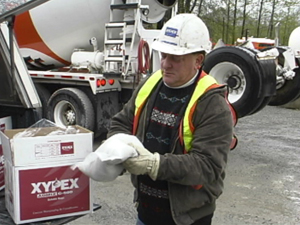Concrete Waterproofing with Crystalline Technology
Curing
Moist curing of the crystalline waterproofing system is essential for proper performance and is extremely important for two reasons:
First, crystalline waterproofing uses water as a diffusing medium which allows the reactive chemicals to transfer from the coating into the saturated concrete substrate. If adequate curing of the crystalline waterproofing does not take place, evaporation will first dry out the coating and then begin to pull moisture from out of the concrete. As the concrete substrate dries, further chemical transfer into the substrate will be compromised thus limiting the effectiveness of the application
Second, the crystalline waterproofing coating uses a sand and cement as a carrying agent for the active chemicals so curing is necessary for proper hardening of the coating and adhesion to the concrete surface. Curing of the treatment is achieved either by spraying with water or through the use of a specialized evaporation retardant.
Curing the crystalline waterproofing coating should begin as soon as it has hardened sufficiently so as not to be damaged by a fine spray. Under normal conditions, the treatment will be ready for moist curing two to three hours after application. This is accomplished by misting with a fog spray of clean water at least three times a day for two to three days to prevent premature drying.
In warm climates or on hot windy days, increased curing will be required to keep the coating from drying out. This can be achieved by misting the coating five or six times per day for two to three days. Curing should be carried out if 70 percent of the coating is dry and 30 percent is still damp. In this case, the next fog spray should be done.
During the curing period, treated surfaces must be protected from damage by rain, frost, and freezing temperatures. If plastic sheeting is used for protection, it must be raised off the waterproofing coating to allow sufficient air circulation. The overall process of crystalline formation may take two to three weeks to reach full maturity.
Use of Crystalline Waterproofing as an Admixture for Concrete
 |
Admix soluble bag Photo courtesy of Xypex |
Adding crystalline waterproofing chemicals to the concrete mix at the batch plant ensures that the crystalline formation occurs uniformly throughout the structure, rather than penetrating from the surface as would be the case with a coating application. Crystalline waterproofing admixture can reduce concrete shrinkage and increase compressive strength. When the crystalline chemicals are added directly to the concrete mix, the same chemical reactions take place but construction costs are significantly reduced because labor associated with a surface treatment application is eliminated and the construction schedule can be accelerated.
The crystalline waterproofing admixture is added to concrete at the time of batching. The sequence of procedures for addition will vary according to the type of batch plant operation and equipment. For most mixtures, the dosage rate is two to three percent, based on the Portland cement content.
Crystalline waterproofing admixtures are compatible with superplasticizers, air entraining agents and water reducers. In addition, fly ash, and other supplementary cementing materials may also be used with crystalline waterproofing to improve the performance of modern concrete mixes. When specifying crystalline waterproofing as an admixture, design professionals should verify that all elements in the concrete mix are compatible with each other.
Dry-Shake Application of Crystalline Waterproofing for New Slab Construction
Crystalline waterproofing can also be applied by the dry-shake application method, like floor hardeners to new slabs while under construction. This process requires the crystalline powder compound to be sprinkled onto the surface of slabs with the use of a mechanical spreader after concrete is placed, consolidated, and leveled. The powder is then worked into the surface of the slab during the normal finishing process with a power trowel. Crystalline waterproofing is also available combined with synthetic floor hardeners to both waterproof and harden floor slabs. Typical applications for the dry-shake application are basement slabs and warehouse floors.
Negative Side Waterproofing
Existing basements that are subject to water seepage through foundation walls and floors can be treated by the application of crystalline waterproofing on the negative side, or inside, of the structure. Coatings that depend on their adhesion to the surface will blister and peel when moisture seeping through the concrete dissolves soluble minerals and deposits them on the surface, under the coating, in the form of efflorescence, a white powdery substance that forms on the concrete surfaces. Because crystalline waterproofing penetrates into the concrete, plugging the pores beneath the surface, it does not depend on surface adhesion and will therefore not blister and peel off, like surface coatings. "I specify crystalline waterproofing on virtually every one of my projects as an admixture for the retaining side of walls where applied membranes cannot be used," says Mel Cole, FCSI, an architectural specifier in Soquel, California.
Vapor transmission through basement floors and walls is a common problem that may lead to damp, musty odors. Testing has shown that the application of crystalline waterproofing under these conditions can reduce vapor flows as much as 50 percent, which in most cases, will result in a drier environment.










